Leadership and Management in Vietcombank
VerifiedAdded on 2023/01/05
|7
|2543
|96
AI Summary
This assignment brief focuses on examining leadership and management theories and their impact on the effectiveness of Vietcombank, a leading bank in Vietnam. It also explores the influence of different leadership and management styles on the organization's culture. The report will discuss various theories, analyze their application in the company, and evaluate their impact on the organization's effectiveness and decision-making processes.
Contribute Materials
Your contribution can guide someone’s learning journey. Share your
documents today.
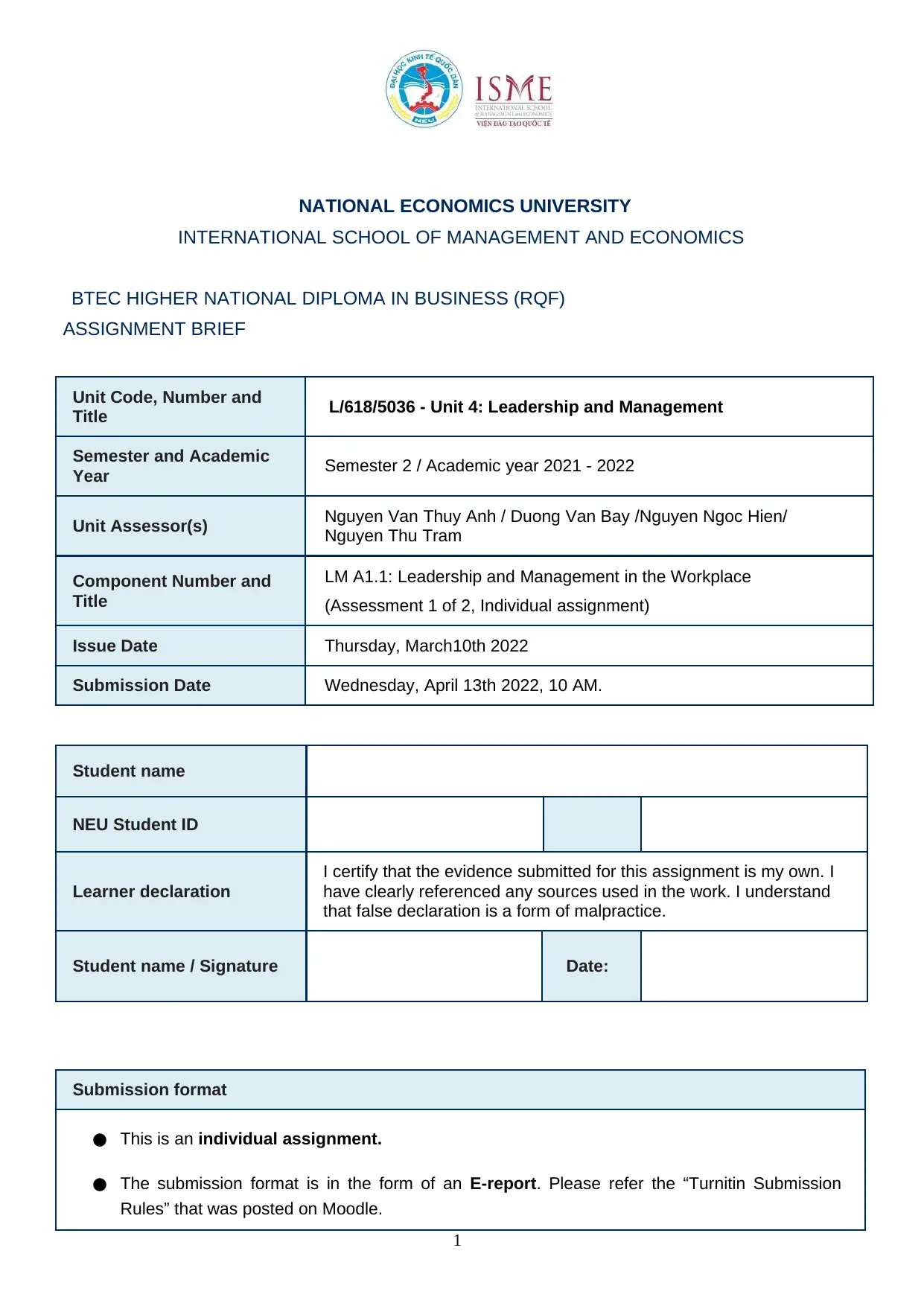
NATIONAL ECONOMICS UNIVERSITY
INTERNATIONAL SCHOOL OF MANAGEMENT AND ECONOMICS
BTEC HIGHER NATIONAL DIPLOMA IN BUSINESS (RQF)
ASSIGNMENT BRIEF
Unit Code, Number and
Title L/618/5036 - Unit 4: Leadership and Management
Semester and Academic
Year Semester 2 / Academic year 2021 - 2022
Unit Assessor(s) Nguyen Van Thuy Anh / Duong Van Bay /Nguyen Ngoc Hien/
Nguyen Thu Tram
Component Number and
Title
LM A1.1: Leadership and Management in the Workplace
(Assessment 1 of 2, Individual assignment)
Issue Date Thursday, March10th 2022
Submission Date Wednesday, April 13th 2022, 10 AM.
Student name
NEU Student ID
Learner declaration
I certify that the evidence submitted for this assignment is my own. I
have clearly referenced any sources used in the work. I understand
that false declaration is a form of malpractice.
Student name / Signature Date:
Submission format
● This is an individual assignment.
● The submission format is in the form of an E-report. Please refer the “Turnitin Submission
Rules” that was posted on Moodle.
1
INTERNATIONAL SCHOOL OF MANAGEMENT AND ECONOMICS
BTEC HIGHER NATIONAL DIPLOMA IN BUSINESS (RQF)
ASSIGNMENT BRIEF
Unit Code, Number and
Title L/618/5036 - Unit 4: Leadership and Management
Semester and Academic
Year Semester 2 / Academic year 2021 - 2022
Unit Assessor(s) Nguyen Van Thuy Anh / Duong Van Bay /Nguyen Ngoc Hien/
Nguyen Thu Tram
Component Number and
Title
LM A1.1: Leadership and Management in the Workplace
(Assessment 1 of 2, Individual assignment)
Issue Date Thursday, March10th 2022
Submission Date Wednesday, April 13th 2022, 10 AM.
Student name
NEU Student ID
Learner declaration
I certify that the evidence submitted for this assignment is my own. I
have clearly referenced any sources used in the work. I understand
that false declaration is a form of malpractice.
Student name / Signature Date:
Submission format
● This is an individual assignment.
● The submission format is in the form of an E-report. Please refer the “Turnitin Submission
Rules” that was posted on Moodle.
1
Secure Best Marks with AI Grader
Need help grading? Try our AI Grader for instant feedback on your assignments.
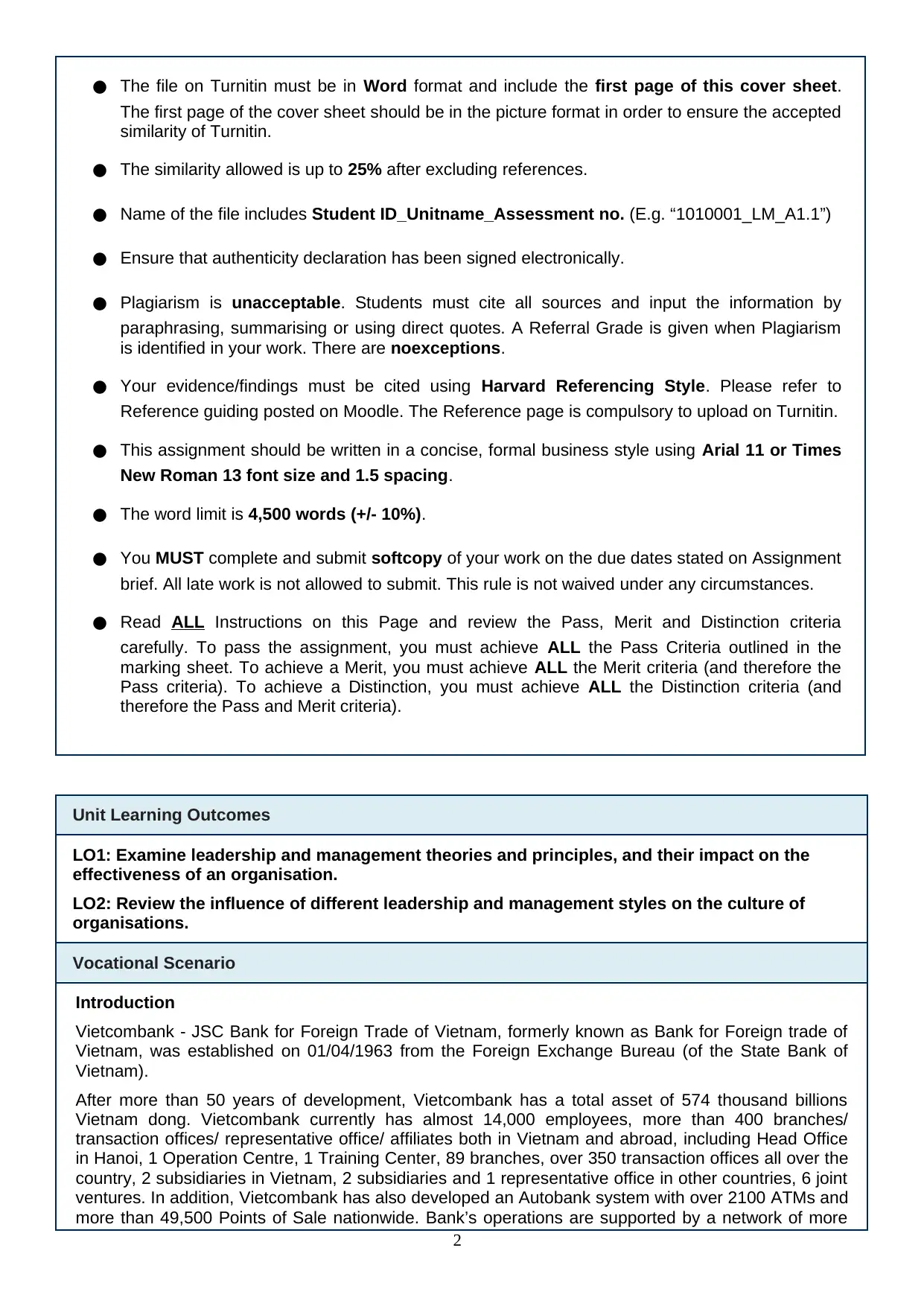
● The file on Turnitin must be in Word format and include the first page of this cover sheet.
The first page of the cover sheet should be in the picture format in order to ensure the accepted
similarity of Turnitin.
● The similarity allowed is up to 25% after excluding references.
● Name of the file includes Student ID_Unitname_Assessment no. (E.g. “1010001_LM_A1.1”)
● Ensure that authenticity declaration has been signed electronically.
● Plagiarism is unacceptable. Students must cite all sources and input the information by
paraphrasing, summarising or using direct quotes. A Referral Grade is given when Plagiarism
is identified in your work. There are noexceptions.
● Your evidence/findings must be cited using Harvard Referencing Style. Please refer to
Reference guiding posted on Moodle. The Reference page is compulsory to upload on Turnitin.
● This assignment should be written in a concise, formal business style using Arial 11 or Times
New Roman 13 font size and 1.5 spacing.
● The word limit is 4,500 words (+/- 10%).
● You MUST complete and submit softcopy of your work on the due dates stated on Assignment
brief. All late work is not allowed to submit. This rule is not waived under any circumstances.
● Read ALL Instructions on this Page and review the Pass, Merit and Distinction criteria
carefully. To pass the assignment, you must achieve ALL the Pass Criteria outlined in the
marking sheet. To achieve a Merit, you must achieve ALL the Merit criteria (and therefore the
Pass criteria). To achieve a Distinction, you must achieve ALL the Distinction criteria (and
therefore the Pass and Merit criteria).
Unit Learning Outcomes
LO1: Examine leadership and management theories and principles, and their impact on the
effectiveness of an organisation.
LO2: Review the influence of different leadership and management styles on the culture of
organisations.
Vocational Scenario
Introduction
Vietcombank - JSC Bank for Foreign Trade of Vietnam, formerly known as Bank for Foreign trade of
Vietnam, was established on 01/04/1963 from the Foreign Exchange Bureau (of the State Bank of
Vietnam).
After more than 50 years of development, Vietcombank has a total asset of 574 thousand billions
Vietnam dong. Vietcombank currently has almost 14,000 employees, more than 400 branches/
transaction offices/ representative office/ affiliates both in Vietnam and abroad, including Head Office
in Hanoi, 1 Operation Centre, 1 Training Center, 89 branches, over 350 transaction offices all over the
country, 2 subsidiaries in Vietnam, 2 subsidiaries and 1 representative office in other countries, 6 joint
ventures. In addition, Vietcombank has also developed an Autobank system with over 2100 ATMs and
more than 49,500 Points of Sale nationwide. Bank’s operations are supported by a network of more
2
The first page of the cover sheet should be in the picture format in order to ensure the accepted
similarity of Turnitin.
● The similarity allowed is up to 25% after excluding references.
● Name of the file includes Student ID_Unitname_Assessment no. (E.g. “1010001_LM_A1.1”)
● Ensure that authenticity declaration has been signed electronically.
● Plagiarism is unacceptable. Students must cite all sources and input the information by
paraphrasing, summarising or using direct quotes. A Referral Grade is given when Plagiarism
is identified in your work. There are noexceptions.
● Your evidence/findings must be cited using Harvard Referencing Style. Please refer to
Reference guiding posted on Moodle. The Reference page is compulsory to upload on Turnitin.
● This assignment should be written in a concise, formal business style using Arial 11 or Times
New Roman 13 font size and 1.5 spacing.
● The word limit is 4,500 words (+/- 10%).
● You MUST complete and submit softcopy of your work on the due dates stated on Assignment
brief. All late work is not allowed to submit. This rule is not waived under any circumstances.
● Read ALL Instructions on this Page and review the Pass, Merit and Distinction criteria
carefully. To pass the assignment, you must achieve ALL the Pass Criteria outlined in the
marking sheet. To achieve a Merit, you must achieve ALL the Merit criteria (and therefore the
Pass criteria). To achieve a Distinction, you must achieve ALL the Distinction criteria (and
therefore the Pass and Merit criteria).
Unit Learning Outcomes
LO1: Examine leadership and management theories and principles, and their impact on the
effectiveness of an organisation.
LO2: Review the influence of different leadership and management styles on the culture of
organisations.
Vocational Scenario
Introduction
Vietcombank - JSC Bank for Foreign Trade of Vietnam, formerly known as Bank for Foreign trade of
Vietnam, was established on 01/04/1963 from the Foreign Exchange Bureau (of the State Bank of
Vietnam).
After more than 50 years of development, Vietcombank has a total asset of 574 thousand billions
Vietnam dong. Vietcombank currently has almost 14,000 employees, more than 400 branches/
transaction offices/ representative office/ affiliates both in Vietnam and abroad, including Head Office
in Hanoi, 1 Operation Centre, 1 Training Center, 89 branches, over 350 transaction offices all over the
country, 2 subsidiaries in Vietnam, 2 subsidiaries and 1 representative office in other countries, 6 joint
ventures. In addition, Vietcombank has also developed an Autobank system with over 2100 ATMs and
more than 49,500 Points of Sale nationwide. Bank’s operations are supported by a network of more
2
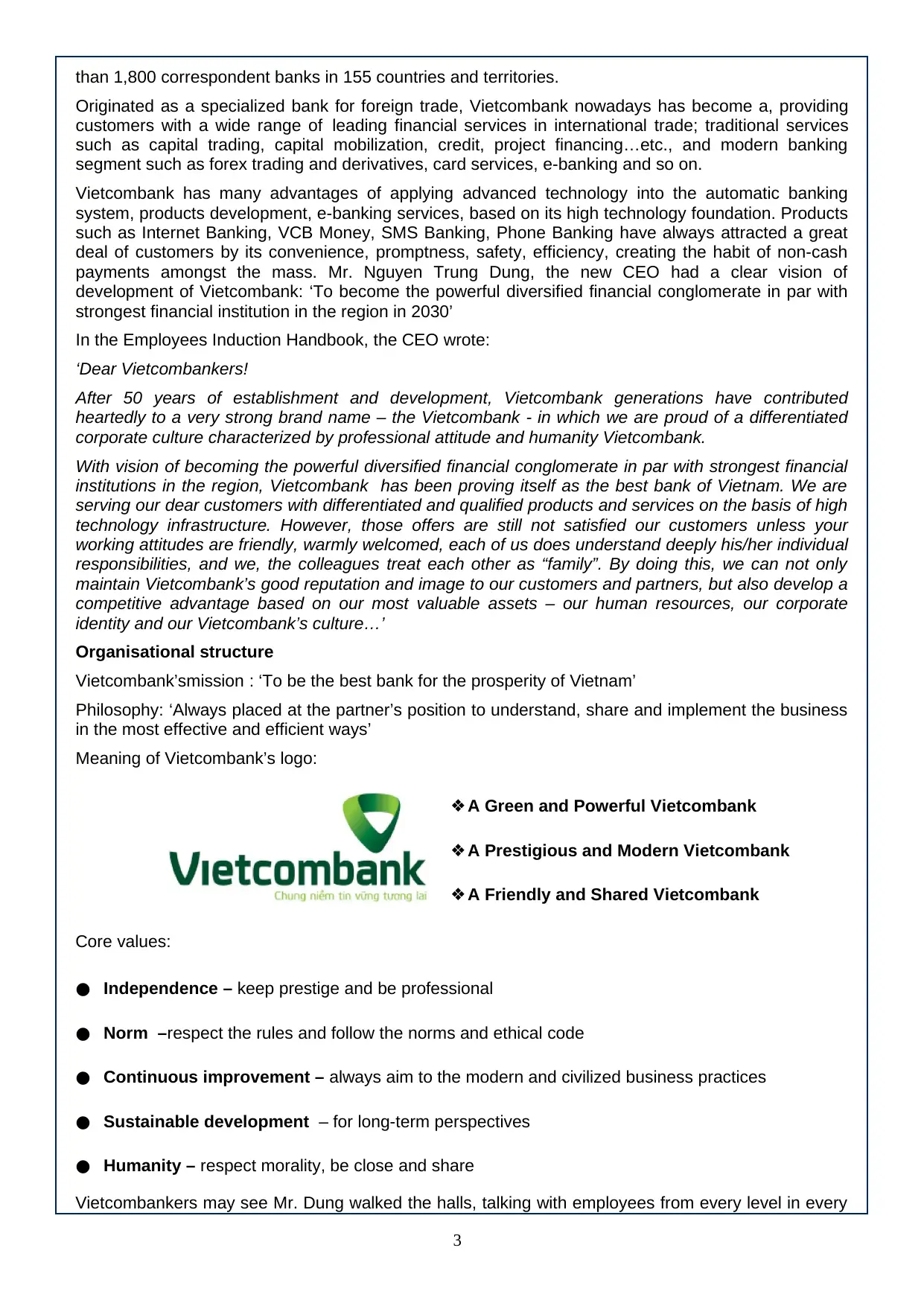
than 1,800 correspondent banks in 155 countries and territories.
Originated as a specialized bank for foreign trade, Vietcombank nowadays has become a, providing
customers with a wide range of leading financial services in international trade; traditional services
such as capital trading, capital mobilization, credit, project financing…etc., and modern banking
segment such as forex trading and derivatives, card services, e-banking and so on.
Vietcombank has many advantages of applying advanced technology into the automatic banking
system, products development, e-banking services, based on its high technology foundation. Products
such as Internet Banking, VCB Money, SMS Banking, Phone Banking have always attracted a great
deal of customers by its convenience, promptness, safety, efficiency, creating the habit of non-cash
payments amongst the mass. Mr. Nguyen Trung Dung, the new CEO had a clear vision of
development of Vietcombank: ‘To become the powerful diversified financial conglomerate in par with
strongest financial institution in the region in 2030’
In the Employees Induction Handbook, the CEO wrote:
‘Dear Vietcombankers!
After 50 years of establishment and development, Vietcombank generations have contributed
heartedly to a very strong brand name – the Vietcombank - in which we are proud of a differentiated
corporate culture characterized by professional attitude and humanity Vietcombank.
With vision of becoming the powerful diversified financial conglomerate in par with strongest financial
institutions in the region, Vietcombank has been proving itself as the best bank of Vietnam. We are
serving our dear customers with differentiated and qualified products and services on the basis of high
technology infrastructure. However, those offers are still not satisfied our customers unless your
working attitudes are friendly, warmly welcomed, each of us does understand deeply his/her individual
responsibilities, and we, the colleagues treat each other as “family”. By doing this, we can not only
maintain Vietcombank’s good reputation and image to our customers and partners, but also develop a
competitive advantage based on our most valuable assets – our human resources, our corporate
identity and our Vietcombank’s culture…’
Organisational structure
Vietcombank’smission : ‘To be the best bank for the prosperity of Vietnam’
Philosophy: ‘Always placed at the partner’s position to understand, share and implement the business
in the most effective and efficient ways’
Meaning of Vietcombank’s logo:
❖ A Green and Powerful Vietcombank
❖ A Prestigious and Modern Vietcombank
❖ A Friendly and Shared Vietcombank
Core values:
● Independence – keep prestige and be professional
● Norm –respect the rules and follow the norms and ethical code
● Continuous improvement – always aim to the modern and civilized business practices
● Sustainable development – for long-term perspectives
● Humanity – respect morality, be close and share
Vietcombankers may see Mr. Dung walked the halls, talking with employees from every level in every
3
Originated as a specialized bank for foreign trade, Vietcombank nowadays has become a, providing
customers with a wide range of leading financial services in international trade; traditional services
such as capital trading, capital mobilization, credit, project financing…etc., and modern banking
segment such as forex trading and derivatives, card services, e-banking and so on.
Vietcombank has many advantages of applying advanced technology into the automatic banking
system, products development, e-banking services, based on its high technology foundation. Products
such as Internet Banking, VCB Money, SMS Banking, Phone Banking have always attracted a great
deal of customers by its convenience, promptness, safety, efficiency, creating the habit of non-cash
payments amongst the mass. Mr. Nguyen Trung Dung, the new CEO had a clear vision of
development of Vietcombank: ‘To become the powerful diversified financial conglomerate in par with
strongest financial institution in the region in 2030’
In the Employees Induction Handbook, the CEO wrote:
‘Dear Vietcombankers!
After 50 years of establishment and development, Vietcombank generations have contributed
heartedly to a very strong brand name – the Vietcombank - in which we are proud of a differentiated
corporate culture characterized by professional attitude and humanity Vietcombank.
With vision of becoming the powerful diversified financial conglomerate in par with strongest financial
institutions in the region, Vietcombank has been proving itself as the best bank of Vietnam. We are
serving our dear customers with differentiated and qualified products and services on the basis of high
technology infrastructure. However, those offers are still not satisfied our customers unless your
working attitudes are friendly, warmly welcomed, each of us does understand deeply his/her individual
responsibilities, and we, the colleagues treat each other as “family”. By doing this, we can not only
maintain Vietcombank’s good reputation and image to our customers and partners, but also develop a
competitive advantage based on our most valuable assets – our human resources, our corporate
identity and our Vietcombank’s culture…’
Organisational structure
Vietcombank’smission : ‘To be the best bank for the prosperity of Vietnam’
Philosophy: ‘Always placed at the partner’s position to understand, share and implement the business
in the most effective and efficient ways’
Meaning of Vietcombank’s logo:
❖ A Green and Powerful Vietcombank
❖ A Prestigious and Modern Vietcombank
❖ A Friendly and Shared Vietcombank
Core values:
● Independence – keep prestige and be professional
● Norm –respect the rules and follow the norms and ethical code
● Continuous improvement – always aim to the modern and civilized business practices
● Sustainable development – for long-term perspectives
● Humanity – respect morality, be close and share
Vietcombankers may see Mr. Dung walked the halls, talking with employees from every level in every
3
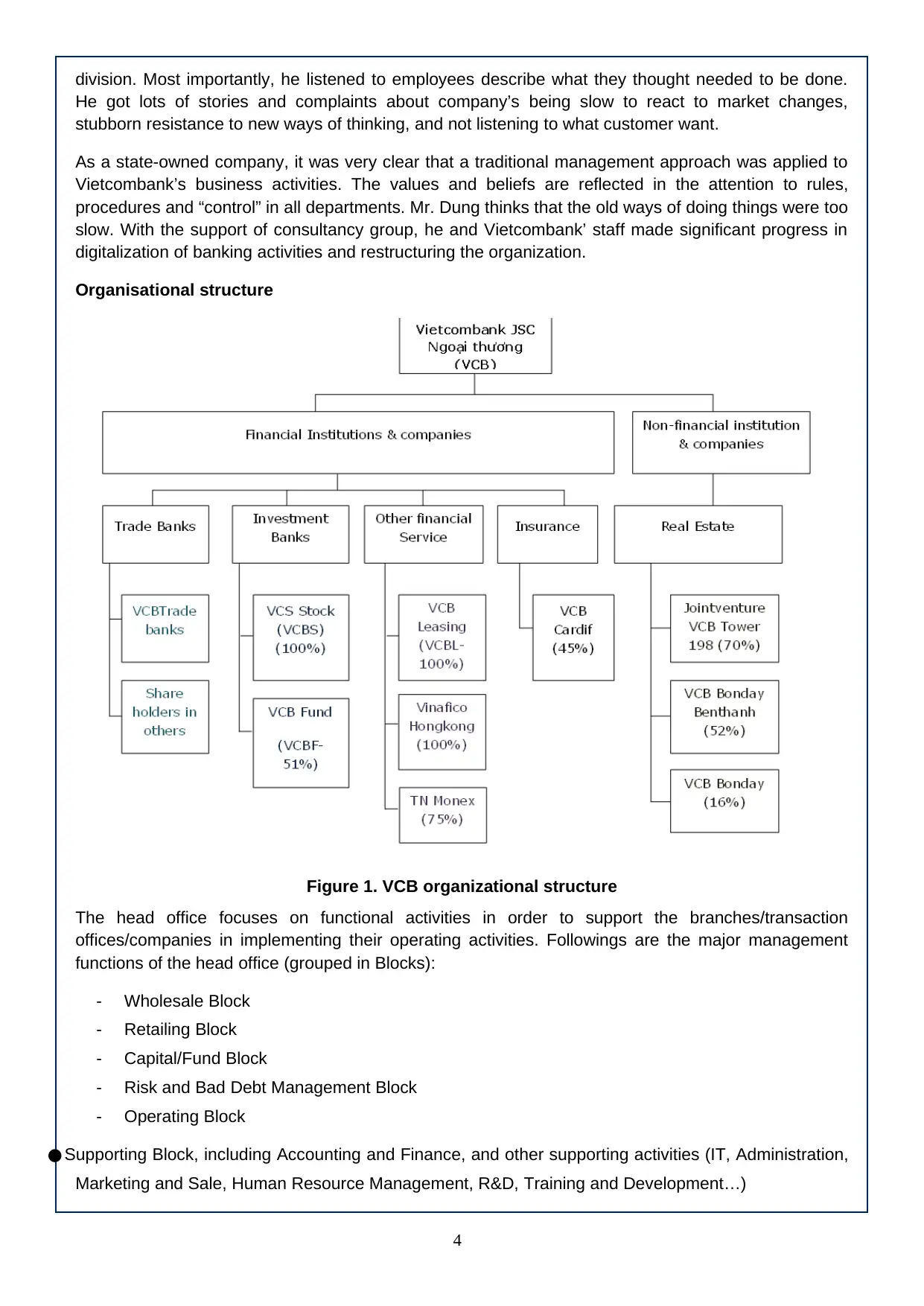
division. Most importantly, he listened to employees describe what they thought needed to be done.
He got lots of stories and complaints about company’s being slow to react to market changes,
stubborn resistance to new ways of thinking, and not listening to what customer want.
As a state-owned company, it was very clear that a traditional management approach was applied to
Vietcombank’s business activities. The values and beliefs are reflected in the attention to rules,
procedures and “control” in all departments. Mr. Dung thinks that the old ways of doing things were too
slow. With the support of consultancy group, he and Vietcombank’ staff made significant progress in
digitalization of banking activities and restructuring the organization.
Organisational structure
Figure 1. VCB organizational structure
The head office focuses on functional activities in order to support the branches/transaction
offices/companies in implementing their operating activities. Followings are the major management
functions of the head office (grouped in Blocks):
- Wholesale Block
- Retailing Block
- Capital/Fund Block
- Risk and Bad Debt Management Block
- Operating Block
● Supporting Block, including Accounting and Finance, and other supporting activities (IT, Administration,
Marketing and Sale, Human Resource Management, R&D, Training and Development…)
4
He got lots of stories and complaints about company’s being slow to react to market changes,
stubborn resistance to new ways of thinking, and not listening to what customer want.
As a state-owned company, it was very clear that a traditional management approach was applied to
Vietcombank’s business activities. The values and beliefs are reflected in the attention to rules,
procedures and “control” in all departments. Mr. Dung thinks that the old ways of doing things were too
slow. With the support of consultancy group, he and Vietcombank’ staff made significant progress in
digitalization of banking activities and restructuring the organization.
Organisational structure
Figure 1. VCB organizational structure
The head office focuses on functional activities in order to support the branches/transaction
offices/companies in implementing their operating activities. Followings are the major management
functions of the head office (grouped in Blocks):
- Wholesale Block
- Retailing Block
- Capital/Fund Block
- Risk and Bad Debt Management Block
- Operating Block
● Supporting Block, including Accounting and Finance, and other supporting activities (IT, Administration,
Marketing and Sale, Human Resource Management, R&D, Training and Development…)
4
Secure Best Marks with AI Grader
Need help grading? Try our AI Grader for instant feedback on your assignments.
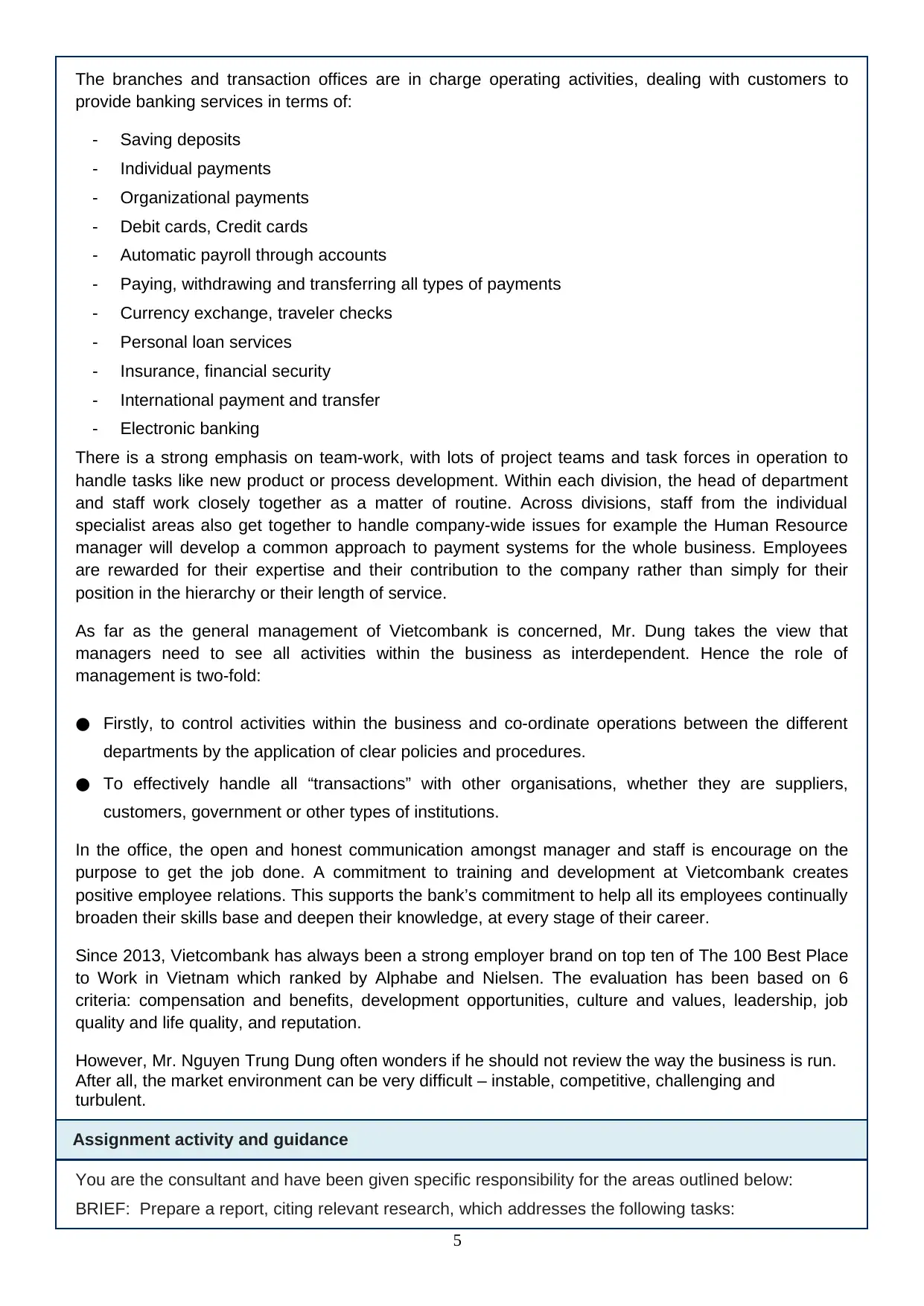
The branches and transaction offices are in charge operating activities, dealing with customers to
provide banking services in terms of:
- Saving deposits
- Individual payments
- Organizational payments
- Debit cards, Credit cards
- Automatic payroll through accounts
- Paying, withdrawing and transferring all types of payments
- Currency exchange, traveler checks
- Personal loan services
- Insurance, financial security
- International payment and transfer
- Electronic banking
There is a strong emphasis on team-work, with lots of project teams and task forces in operation to
handle tasks like new product or process development. Within each division, the head of department
and staff work closely together as a matter of routine. Across divisions, staff from the individual
specialist areas also get together to handle company-wide issues for example the Human Resource
manager will develop a common approach to payment systems for the whole business. Employees
are rewarded for their expertise and their contribution to the company rather than simply for their
position in the hierarchy or their length of service.
As far as the general management of Vietcombank is concerned, Mr. Dung takes the view that
managers need to see all activities within the business as interdependent. Hence the role of
management is two-fold:
● Firstly, to control activities within the business and co-ordinate operations between the different
departments by the application of clear policies and procedures.
● To effectively handle all “transactions” with other organisations, whether they are suppliers,
customers, government or other types of institutions.
In the office, the open and honest communication amongst manager and staff is encourage on the
purpose to get the job done. A commitment to training and development at Vietcombank creates
positive employee relations. This supports the bank’s commitment to help all its employees continually
broaden their skills base and deepen their knowledge, at every stage of their career.
Since 2013, Vietcombank has always been a strong employer brand on top ten of The 100 Best Place
to Work in Vietnam which ranked by Alphabe and Nielsen. The evaluation has been based on 6
criteria: compensation and benefits, development opportunities, culture and values, leadership, job
quality and life quality, and reputation.
However, Mr. Nguyen Trung Dung often wonders if he should not review the way the business is run.
After all, the market environment can be very difficult – instable, competitive, challenging and
turbulent.
Assignment activity and guidance
You are the consultant and have been given specific responsibility for the areas outlined below:
BRIEF: Prepare a report, citing relevant research, which addresses the following tasks:
5
provide banking services in terms of:
- Saving deposits
- Individual payments
- Organizational payments
- Debit cards, Credit cards
- Automatic payroll through accounts
- Paying, withdrawing and transferring all types of payments
- Currency exchange, traveler checks
- Personal loan services
- Insurance, financial security
- International payment and transfer
- Electronic banking
There is a strong emphasis on team-work, with lots of project teams and task forces in operation to
handle tasks like new product or process development. Within each division, the head of department
and staff work closely together as a matter of routine. Across divisions, staff from the individual
specialist areas also get together to handle company-wide issues for example the Human Resource
manager will develop a common approach to payment systems for the whole business. Employees
are rewarded for their expertise and their contribution to the company rather than simply for their
position in the hierarchy or their length of service.
As far as the general management of Vietcombank is concerned, Mr. Dung takes the view that
managers need to see all activities within the business as interdependent. Hence the role of
management is two-fold:
● Firstly, to control activities within the business and co-ordinate operations between the different
departments by the application of clear policies and procedures.
● To effectively handle all “transactions” with other organisations, whether they are suppliers,
customers, government or other types of institutions.
In the office, the open and honest communication amongst manager and staff is encourage on the
purpose to get the job done. A commitment to training and development at Vietcombank creates
positive employee relations. This supports the bank’s commitment to help all its employees continually
broaden their skills base and deepen their knowledge, at every stage of their career.
Since 2013, Vietcombank has always been a strong employer brand on top ten of The 100 Best Place
to Work in Vietnam which ranked by Alphabe and Nielsen. The evaluation has been based on 6
criteria: compensation and benefits, development opportunities, culture and values, leadership, job
quality and life quality, and reputation.
However, Mr. Nguyen Trung Dung often wonders if he should not review the way the business is run.
After all, the market environment can be very difficult – instable, competitive, challenging and
turbulent.
Assignment activity and guidance
You are the consultant and have been given specific responsibility for the areas outlined below:
BRIEF: Prepare a report, citing relevant research, which addresses the following tasks:
5
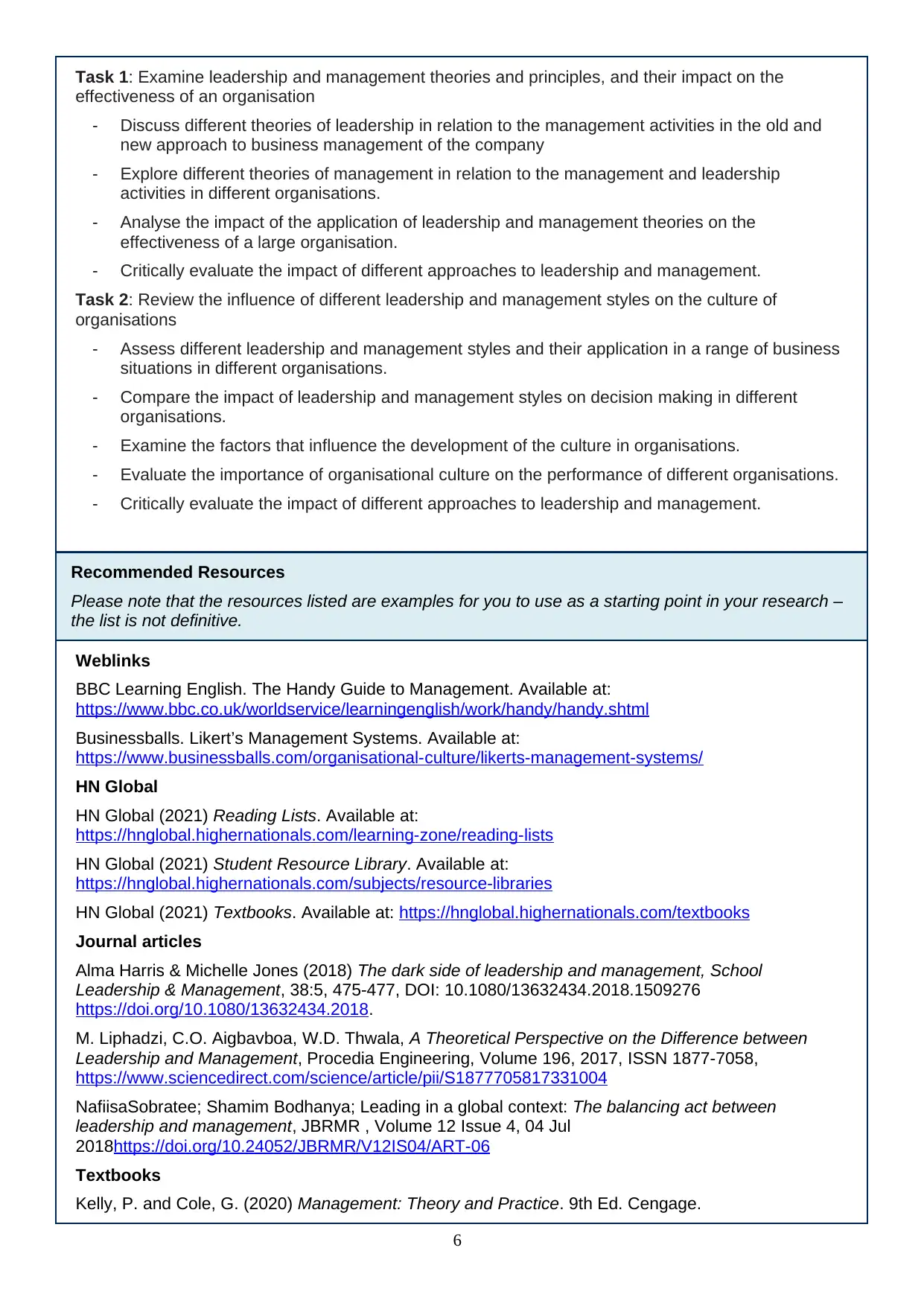
Task 1: Examine leadership and management theories and principles, and their impact on the
effectiveness of an organisation
- Discuss different theories of leadership in relation to the management activities in the old and
new approach to business management of the company
- Explore different theories of management in relation to the management and leadership
activities in different organisations.
- Analyse the impact of the application of leadership and management theories on the
effectiveness of a large organisation.
- Critically evaluate the impact of different approaches to leadership and management.
Task 2: Review the influence of different leadership and management styles on the culture of
organisations
- Assess different leadership and management styles and their application in a range of business
situations in different organisations.
- Compare the impact of leadership and management styles on decision making in different
organisations.
- Examine the factors that influence the development of the culture in organisations.
- Evaluate the importance of organisational culture on the performance of different organisations.
- Critically evaluate the impact of different approaches to leadership and management.
Recommended Resources
Please note that the resources listed are examples for you to use as a starting point in your research –
the list is not definitive.
Weblinks
BBC Learning English. The Handy Guide to Management. Available at:
https://www.bbc.co.uk/worldservice/learningenglish/work/handy/handy.shtml
Businessballs. Likert’s Management Systems. Available at:
https://www.businessballs.com/organisational-culture/likerts-management-systems/
HN Global
HN Global (2021) Reading Lists. Available at:
https://hnglobal.highernationals.com/learning-zone/reading-lists
HN Global (2021) Student Resource Library. Available at:
https://hnglobal.highernationals.com/subjects/resource-libraries
HN Global (2021) Textbooks. Available at: https://hnglobal.highernationals.com/textbooks
Journal articles
Alma Harris & Michelle Jones (2018) The dark side of leadership and management, School
Leadership & Management, 38:5, 475-477, DOI: 10.1080/13632434.2018.1509276
https://doi.org/10.1080/13632434.2018.
M. Liphadzi, C.O. Aigbavboa, W.D. Thwala, A Theoretical Perspective on the Difference between
Leadership and Management, Procedia Engineering, Volume 196, 2017, ISSN 1877-7058,
https://www.sciencedirect.com/science/article/pii/S1877705817331004
NafiisaSobratee; Shamim Bodhanya; Leading in a global context: The balancing act between
leadership and management, JBRMR , Volume 12 Issue 4, 04 Jul
2018https://doi.org/10.24052/JBRMR/V12IS04/ART-06
Textbooks
Kelly, P. and Cole, G. (2020) Management: Theory and Practice. 9th Ed. Cengage.
6
effectiveness of an organisation
- Discuss different theories of leadership in relation to the management activities in the old and
new approach to business management of the company
- Explore different theories of management in relation to the management and leadership
activities in different organisations.
- Analyse the impact of the application of leadership and management theories on the
effectiveness of a large organisation.
- Critically evaluate the impact of different approaches to leadership and management.
Task 2: Review the influence of different leadership and management styles on the culture of
organisations
- Assess different leadership and management styles and their application in a range of business
situations in different organisations.
- Compare the impact of leadership and management styles on decision making in different
organisations.
- Examine the factors that influence the development of the culture in organisations.
- Evaluate the importance of organisational culture on the performance of different organisations.
- Critically evaluate the impact of different approaches to leadership and management.
Recommended Resources
Please note that the resources listed are examples for you to use as a starting point in your research –
the list is not definitive.
Weblinks
BBC Learning English. The Handy Guide to Management. Available at:
https://www.bbc.co.uk/worldservice/learningenglish/work/handy/handy.shtml
Businessballs. Likert’s Management Systems. Available at:
https://www.businessballs.com/organisational-culture/likerts-management-systems/
HN Global
HN Global (2021) Reading Lists. Available at:
https://hnglobal.highernationals.com/learning-zone/reading-lists
HN Global (2021) Student Resource Library. Available at:
https://hnglobal.highernationals.com/subjects/resource-libraries
HN Global (2021) Textbooks. Available at: https://hnglobal.highernationals.com/textbooks
Journal articles
Alma Harris & Michelle Jones (2018) The dark side of leadership and management, School
Leadership & Management, 38:5, 475-477, DOI: 10.1080/13632434.2018.1509276
https://doi.org/10.1080/13632434.2018.
M. Liphadzi, C.O. Aigbavboa, W.D. Thwala, A Theoretical Perspective on the Difference between
Leadership and Management, Procedia Engineering, Volume 196, 2017, ISSN 1877-7058,
https://www.sciencedirect.com/science/article/pii/S1877705817331004
NafiisaSobratee; Shamim Bodhanya; Leading in a global context: The balancing act between
leadership and management, JBRMR , Volume 12 Issue 4, 04 Jul
2018https://doi.org/10.24052/JBRMR/V12IS04/ART-06
Textbooks
Kelly, P. and Cole, G. (2020) Management: Theory and Practice. 9th Ed. Cengage.
6
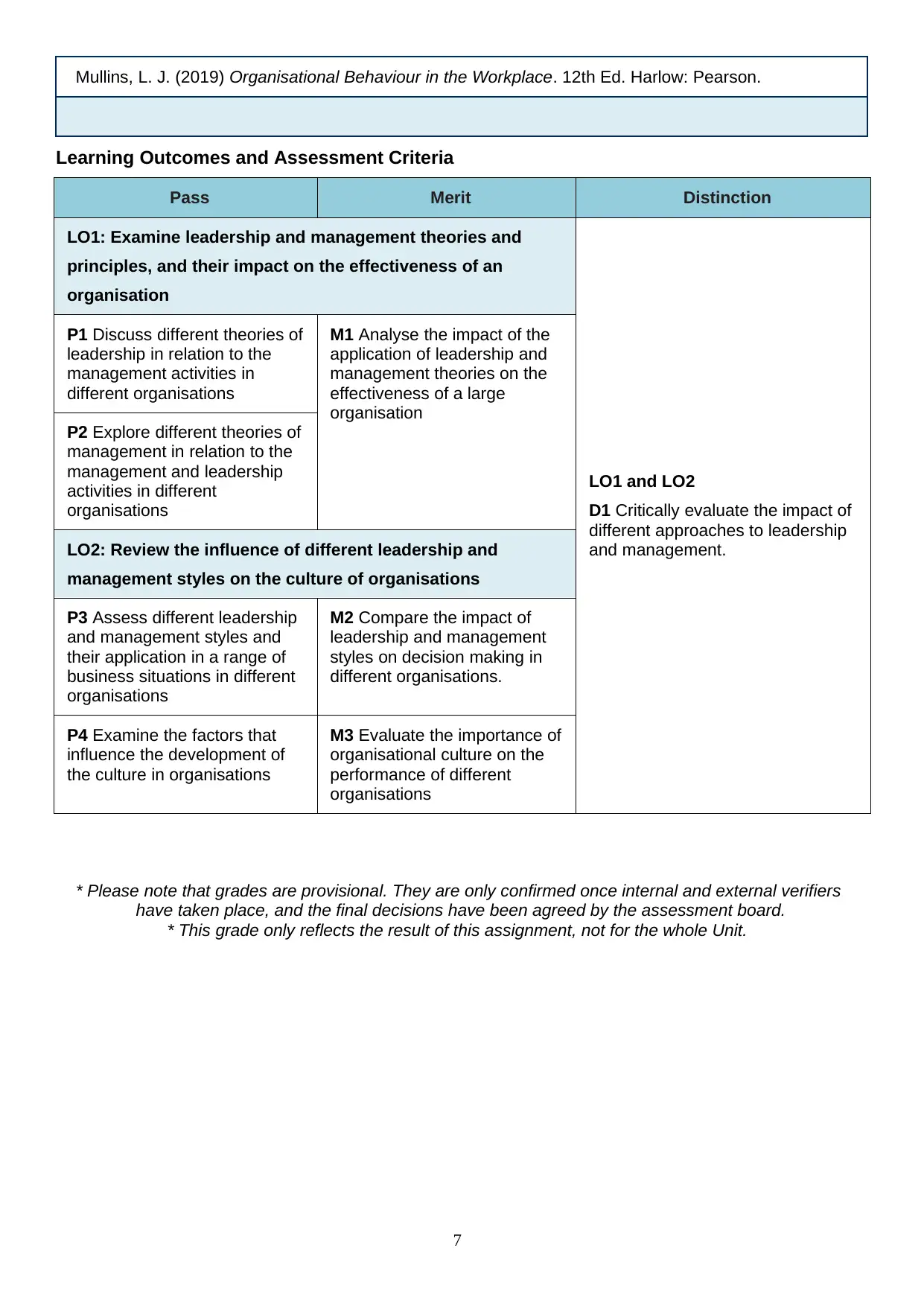
Mullins, L. J. (2019) Organisational Behaviour in the Workplace. 12th Ed. Harlow: Pearson.
Learning Outcomes and Assessment Criteria
Pass Merit Distinction
LO1: Examine leadership and management theories and
principles, and their impact on the effectiveness of an
organisation
LO1 and LO2
D1 Critically evaluate the impact of
different approaches to leadership
and management.
P1 Discuss different theories of
leadership in relation to the
management activities in
different organisations
M1 Analyse the impact of the
application of leadership and
management theories on the
effectiveness of a large
organisation
P2 Explore different theories of
management in relation to the
management and leadership
activities in different
organisations
LO2: Review the influence of different leadership and
management styles on the culture of organisations
P3 Assess different leadership
and management styles and
their application in a range of
business situations in different
organisations
M2 Compare the impact of
leadership and management
styles on decision making in
different organisations.
P4 Examine the factors that
influence the development of
the culture in organisations
M3 Evaluate the importance of
organisational culture on the
performance of different
organisations
* Please note that grades are provisional. They are only confirmed once internal and external verifiers
have taken place, and the final decisions have been agreed by the assessment board.
* This grade only reflects the result of this assignment, not for the whole Unit.
7
Learning Outcomes and Assessment Criteria
Pass Merit Distinction
LO1: Examine leadership and management theories and
principles, and their impact on the effectiveness of an
organisation
LO1 and LO2
D1 Critically evaluate the impact of
different approaches to leadership
and management.
P1 Discuss different theories of
leadership in relation to the
management activities in
different organisations
M1 Analyse the impact of the
application of leadership and
management theories on the
effectiveness of a large
organisation
P2 Explore different theories of
management in relation to the
management and leadership
activities in different
organisations
LO2: Review the influence of different leadership and
management styles on the culture of organisations
P3 Assess different leadership
and management styles and
their application in a range of
business situations in different
organisations
M2 Compare the impact of
leadership and management
styles on decision making in
different organisations.
P4 Examine the factors that
influence the development of
the culture in organisations
M3 Evaluate the importance of
organisational culture on the
performance of different
organisations
* Please note that grades are provisional. They are only confirmed once internal and external verifiers
have taken place, and the final decisions have been agreed by the assessment board.
* This grade only reflects the result of this assignment, not for the whole Unit.
7
1 out of 7
Related Documents
Your All-in-One AI-Powered Toolkit for Academic Success.
+13062052269
info@desklib.com
Available 24*7 on WhatsApp / Email
![[object Object]](/_next/static/media/star-bottom.7253800d.svg)
Unlock your academic potential
© 2024 | Zucol Services PVT LTD | All rights reserved.





